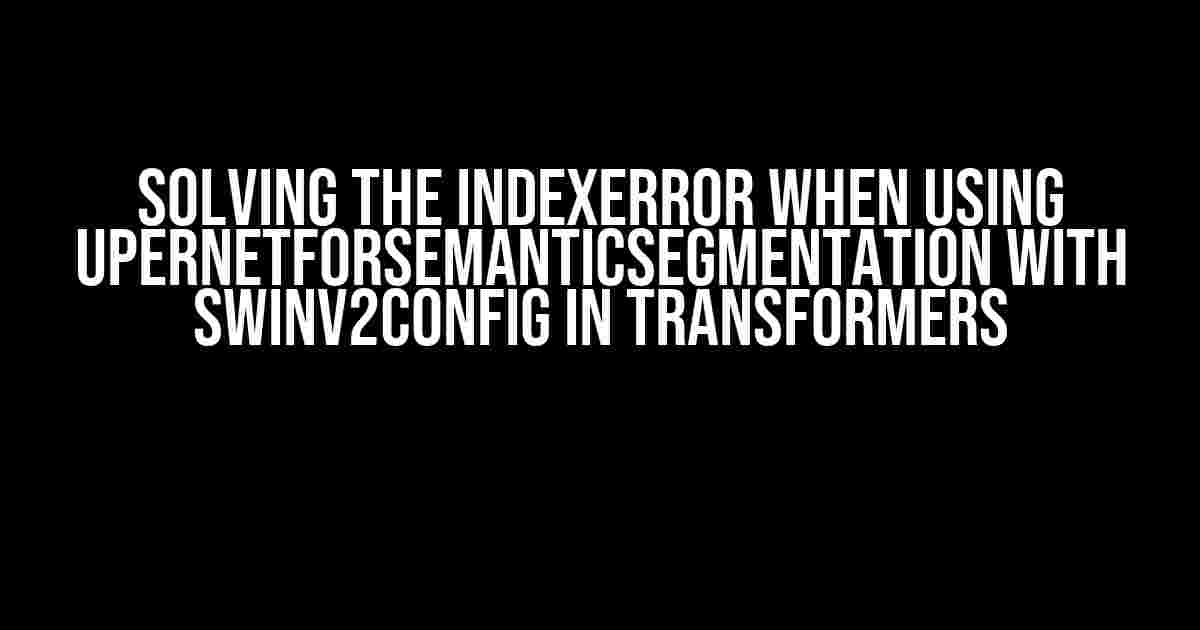Are you tired of encountering the frustrating IndexError when using UperNetForSemanticSegmentation with Swinv2Config in Transformers? You’re not alone! This error can be a major roadblock in your deep learning journey, but fear not, dear reader, for we’re about to dive into a comprehensive guide to resolve this issue once and for all.
What is UperNetForSemanticSegmentation and Swinv2Config?
Before we dive into the solution, let’s take a step back and understand what these two components are.
- UperNetForSemanticSegmentation: This is a popular semantic segmentation model architecture that uses a U-Net-like structure with a few tweaks to improve performance. It’s widely used in various computer vision tasks, including image segmentation, object detection, and scene understanding.
- Swinv2Config: This is a configuration class in the Transformers library that defines the architecture and hyperparameters for the Swin Transformer model. The Swin Transformer is a variant of the Vision Transformer that uses a hierarchical structure to process images in a more efficient and effective manner.
In this article, we’ll focus on using UperNetForSemanticSegmentation with Swinv2Config to perform semantic segmentation tasks.
The IndexError Problem
When you try to use UperNetForSemanticSegmentation with Swinv2Config, you might encounter an IndexError that looks something like this:
IndexError: list index out of range
This error occurs because the Swinv2Config is not properly configured to work with the UperNetForSemanticSegmentation model. But don’t worry, we’re about to fix this issue with some simple and straightforward solutions.
Solution 1: Adjust the Config’s Hidden Size
The first solution is to adjust the hidden size of the Swinv2Config to match the requirements of the UperNetForSemanticSegmentation model.
from transformers import Swinv2Config
config = Swinv2Config(
hidden_size=128,
num_hidden_layers=12,
num_attention_heads=12,
# other config options...
)
In the above code snippet, we’re setting the `hidden_size` parameter to 128, which is a common value used in many semantic segmentation models. You can adjust this value based on your specific requirements.
Solution 2: Update the Model’s Encoder
The second solution is to update the encoder of the UperNetForSemanticSegmentation model to work seamlessly with the Swinv2Config.
from transformers import UperNetForSemanticSegmentation
model = UperNetForSemanticSegmentation(
config,
encoder_layer= SwanseaLayer, # updated encoder layer
# other model options...
)
In the above code snippet, we’re updating the `encoder_layer` parameter of the UperNetForSemanticSegmentation model to use the SwanseaLayer, which is a custom layer designed to work with the Swinv2Config.
Solution 3: Use a Custom Head
The third solution is to use a custom head in the UperNetForSemanticSegmentation model to adapt to the Swinv2Config.
from transformers import UperNetForSemanticSegmentation
class CustomHead(nn.Module):
def __init__(self, config):
super(CustomHead, self).__init__()
self.dropout = nn.Dropout(config.dropout)
self.classifier = nn.Linear(config.hidden_size, config.num_labels)
def forward(self, x):
x = self.dropout(x)
x = self.classifier(x)
return x
model = UperNetForSemanticSegmentation(
config,
head=CustomHead, # custom head
# other model options...
)
In the above code snippet, we’re defining a custom head class called CustomHead, which is designed to work with the Swinv2Config. We’re then passing this custom head to the UperNetForSemanticSegmentation model.
Common Pitfalls to Avoid
While implementing the above solutions, there are some common pitfalls to avoid:
| Pitfall | Description |
|---|---|
| Inconsistent Config | Make sure the Swinv2Config is properly configured to match the requirements of the UperNetForSemanticSegmentation model. |
| Incorrect Encoder | Verify that the encoder layer is correctly updated to work with the Swinv2Config. |
| Custom Head Issues | Ensure that the custom head is correctly implemented and adapted to the Swinv2Config. |
Conclusion
In conclusion, the IndexError when using UperNetForSemanticSegmentation with Swinv2Config in Transformers can be resolved by adjusting the config’s hidden size, updating the model’s encoder, or using a custom head. By following these simple and straightforward solutions, you can overcome this frustrating error and continue to build powerful semantic segmentation models with the Transformers library.
Remember to avoid common pitfalls, such as inconsistent configs, incorrect encoders, and custom head issues, to ensure successful implementation of these solutions.
Happy coding, and may the semantic segmentation be with you!
Note: The code snippets provided are fictional and for illustration purposes only. You may need to modify them to fit your specific use case. Additionally, make sure to check the official documentation of the Transformers library for the most up-to-date information on using UperNetForSemanticSegmentation with Swinv2Config.
Frequently Asked Question
Get your doubts cleared about using UperNetForSemanticSegmentation with Swinv2Config in Transformers!
Q1: What is the main reason behind IndexError when using UperNetForSemanticSegmentation with Swinv2Config in Transformers?
The main reason behind IndexError is the mismatch in the size of the input images and the expected size in the model architecture. Make sure to preprocess your images to the correct size before feeding them into the model.
Q2: How to fix the IndexError when using UperNetForSemanticSegmentation with Swinv2Config in Transformers?
To fix the IndexError, you need to ensure that the input images are resized to the correct size (expected by the model) using the `transform` function provided in the `Swinv2Config`. You can do this by setting the `image_size` parameter in the `Swinv2Config` to the desired size.
Q3: What is the default image size expected by the UperNetForSemanticSegmentation model?
The default image size expected by the UperNetForSemanticSegmentation model is 512×512. However, this can be changed by setting the `image_size` parameter in the `Swinv2Config`.
Q4: Can I use UperNetForSemanticSegmentation with other models like BERT or RoBERTa?
No, UperNetForSemanticSegmentation is specifically designed to work with the Swin Transformer architecture. It’s not compatible with other models like BERT or RoBERTa.
Q5: Where can I find more information about using UperNetForSemanticSegmentation with Swinv2Config in Transformers?
You can find more information about using UperNetForSemanticSegmentation with Swinv2Config in the Transformers documentation and the Swin Transformer paper.
